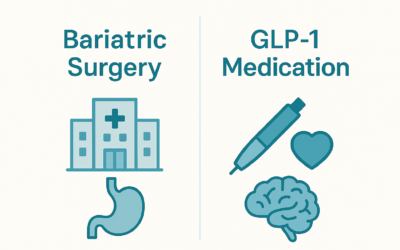Weight loss medications have come a long way in the last decade, but picking the right one isn’t just about numbers or clinical trials. It’s about what fits your actual life. How you eat, how you feel, how much flexibility you need—it all matters just as much as what the clinical trials say.
Ozempic and Mounjaro are two of the biggest names in weight loss right now, and for good reason. They both help people lose weight, and they do it really well. But they don’t do it in exactly the same way — and that difference could be the thing that makes one a perfect fit for you while the other feels like a struggle.
So which of these medications makes more sense for you? This guide breaks down Mounjaro vs. Ozempic in a way that actually matters — not just the science, but the real-world factors that will decide whether or not you can stick with it once you start. Because the best weight-loss medication isn’t the one with the flashiest study results. It’s the one you can take, tolerate, and make work for your life.
Ozempic vs. Mounjaro: How they work
If you’re looking into weight-loss medications, you’ve probably seen the terms GLP-1, GIP, and receptors thrown around like everyone’s supposed to know what they mean. But let’s be real — most people don’t. And if you don’t understand how these medications work, it’s hard to make a truly informed choice.
So let’s break it down.
Your body naturally produces hormones that help control how much you eat, how full you feel, and how your body stores and burns energy. Two of the big ones involved in this process are GLP-1 (glucagon-like peptide-1) and GIP (glucose-dependent insulinotropic polypeptide). These hormones send signals to special parts of your body called receptors, which act like tiny switches that turn different processes on or off.
GLP-1 receptors are found in your brain, your stomach, and your pancreas. When GLP-1 binds to them, a few important things happen:
- Your brain gets the signal that you’re full, making you feel less hungry.
- Your stomach slows down digestion, so food stays in there longer and you keep feeling satisfied.
- Your pancreas releases insulin (another hormone), which helps regulate your blood sugar. Stable blood sugar helps prevent energy crashes and cravings, making it easier to eat less and stay on track with weight loss.
Ozempic is a GLP-1 receptor agonist, which means it mimics the GLP-1 hormone, activating those receptors and triggering those signals. That’s why people who take Ozempic eat less, feel fuller longer, and lose weight. Mounjaro, on the other hand, works on both GLP-1 and GIP receptors. But why does that matter?
GIP receptors are mainly found in fat cells, muscles, and the pancreas. When GIP binds to its receptors, it:
- Helps your body burn fat more efficiently.
- Supports insulin release, keeping your blood sugar stable.
- Works alongside GLP-1 to curb your appetite and improve your metabolism.
Because Mounjaro activates both GLP-1 and GIP receptors, it has the potential to do everything Ozempic does plus give your body an extra boost in fat burning and energy use.
So, when looking at Mounjaro vs. Ozempic, the biggest difference is this: Ozempic focuses only on GLP-1, while Mounjaro taps into both GLP-1 and GIP. That added GIP activation might be the reason why studies show Mounjaro can lead to even greater weight loss than Ozempic.
Does that mean Mounjaro is automatically the better choice? Not necessarily. Some people respond well to GLP-1 alone, while others may see bigger benefits from the dual approach. The best medication is the one that works with your body—not just the one that looks best on paper.
Ozempic vs. Mounjaro: Dosing schedules and convenience
At first glance, Ozempic and Mounjaro look the same when it comes to dosing—one injection a week, no daily pills, no complicated schedules. But once you dig into the details, the way these medications are dosed could actually make a difference in how well they fit into your life. When comparing Mounjaro vs. Ozempic, these differences in dosing flexibility might be an important factor in deciding which one works best for you.
Ozempic starts at a low dose and increases gradually. Most people begin with 0.25 mg once a week for four weeks before moving up to 0.5 mg. If more weight loss is needed and side effects are manageable, the dose can go up to 1 mg or even 2 mg. Mounjaro follows a similar structure but has a wider range of dosing options. It starts at 2.5 mg per week, then increases to 5 mg, and from there, doses can keep stepping up in 2.5 mg increments all the way to 15 mg—the highest approved dose.
At first, all of this might sound like a minor detail, but it actually matters more than you’d think. For one, a higher dose can mean stronger appetite suppression, which is part of why people on Mounjaro sometimes see faster weight loss than those on Ozempic. But higher doses can also mean stronger side effects, which is why having more flexibility can be a good thing. With Ozempic, the jumps between doses are bigger, which means fewer options if you’re struggling to tolerate it but still want to keep going. Mounjaro gives you more room to fine-tune your dose, which might make a difference in how smoothly your body adjusts.
The other factor is timing. Some people want to ease in slowly and let their body get used to the medication, while others want to reach their full dose as quickly as possible to see results faster. Ozempic follows a more gradual approach, while Mounjaro allows for quicker dose increases and a higher maximum dose, which could help people reach their weight-loss goals sooner.
At the end of the day, both medications are designed to be simple and convenient. But if you want a structured, steady approach, Ozempic might be the better fit. If you’re looking for more flexibility and the potential for faster results, Mounjaro could be the way to go.
Ozempic vs. Mounjaro: Weight-loss results
At the end of the day, the biggest question most people have isn’t about dosing or even about how the medication works — it’s about results. How much weight can you actually lose? And how long will it take?
Ozempic has been around longer, and its results are well-documented. In clinical trials, people taking semaglutide, the active ingredient in Ozempic, lost an average of 15% of their body weight when paired with lifestyle changes. For most, that’s a meaningful drop — enough to dramatically change how they look, how they feel, and how they go about their daily lives. This weight loss didn’t happen overnight, though. Most people saw steady progress over several months, with the biggest changes happening between months three and six.
But Mounjaro has raised the bar. In head-to-head trials against semaglutide, people taking tirzepatide, Mounjaro’s active ingredient, lost up to 20% of their body weight on higher doses. That’s a level of weight loss that, until now, was nearly unheard of with medication. And for many, the weight came off faster. Studies suggest that people on Mounjaro tend to hit major weight-loss milestones sooner than those on Ozempic, likely because its dual-action mechanism suppresses appetite even more aggressively.
When comparing Mounjaro vs. Ozempic, this difference in weight loss results stands out. Mounjaro appears to offer a greater potential for fat loss, but that doesn’t necessarily mean it’s the best choice for everyone. Some people respond incredibly well to GLP-1 alone and may not need the added effects of GIP. Others may find that the stronger weight loss on Mounjaro comes with more intense side effects, making it harder to tolerate. In the end, it’s not just about which drug leads to the most weight loss in studies—it’s about which one works best for you.
Ozempic vs. Mounjaro: Which fits your lifestyle best?
Both Ozempic and Mounjaro have reshaped the way we think about medical weight loss, but the best choice isn’t just about the numbers. The right medication isn’t the one that looks best in clinical trials. It’s the one you can take consistently, tolerate well, and actually stick with long enough to see results.
If you’re looking for a medication with a longer track record and a steady, gradual approach, Ozempic might be the better fit. It’s been around longer, has well-established data, and follows a more structured dosing schedule. Some people prefer this because they know exactly what to expect as they adjust.
If you want the potential for greater weight loss, a bit more flexibility in dosing, and don’t mind ramping up more quickly, Mounjaro might be the better option. The added GIP action may give it an edge when it comes to fat loss, and the wider range of dose adjustments could make it easier to find the right balance between effectiveness and tolerability.
Of course, no matter which one you choose, the most important thing is consistency. Neither of these medications works overnight, and long-term success comes from finding a treatment that works with your body, your lifestyle, and your goals. In the end, Mounjaro vs. Ozempic comes down to more than just weight loss—it’s about which medication fits into your life in a way that makes long-term success possible.
If you’re ready to take the next step, Claya makes it easy. Learn more about Claya’s weight loss treatment programs for medically supervised weight loss.



